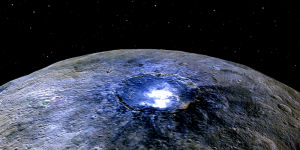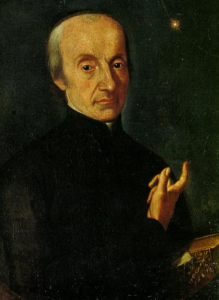
On January 1, 1801, the Italian priest, mathematician and astronomer Giuseppe Piazzi discovered the first asteroid, now called Ceres. It orbits in the asteroid belt, between the orbits of Mars and Jupiter. These days, Ceres is no longer classified as an asteroid, however. In 2006, the International Astronomical Union decided Ceres was big enough to be designated a dwarf planet. Ceres became the first-ever dwarf planet to be orbited by a spacecraft, from 2015 to 2018, when NASA’s Dawn mission peered down at Ceres and unlocked some of its mysteries.
EarthSky 2021 lunar calendars are still in stock, but going fast. Order now!
The story of the discovery of Ceres goes back to German astronomer Johannes Kepler and to Tycho Brahe, a Danish nobleman and inveterate night sky observer, in the 1500s. When Kepler obtained Tycho’s astronomical data, he searched it for the explanation behind the motion of the planets, in particular Mars’ retrograde motion. This work led Kepler to what is one of his most praised discoveries, what we today know as Kepler’s three laws of planetary motion.
However, Kepler’s analysis also led him to discover something else. He noticed an unusually large empty area between the orbits of the planets Mars and Jupiter. This gap, combined with his realization of the regularity of the planets’ orbits, provoked Kepler to assert there must be something in the gap. He thought it might be an undiscovered planet and famously wrote:
Between Jupiter and Mars, I place a planet.
Kepler wasn’t the only one to notice this strange gap. At the beginning of the 18th century, Johann Titius, a Prussian astronomer, stated a relationship between the planet’s orbital distances from the sun, later popularized by German astronomer Johann Bode, today called the Titius-Bode Law. Briefly … begin with a 0, and then 3, and then double each subsequent number. If you do that, you get a series: 0, 3, 6, 12, 24, 48, etc. Then add 4 and divide by 10, and you get (more or less) the distances in astronomical units (AU) to the major planets of our solar system: 0.4, 0.7, 1.0, 1.6, 2.8, 5.2, and so on. But notice that 2.8 AU. It corresponds to the distance of the space between Mars and Jupiter.
But, still, nobody thought much about a possible planet between Mars and Jupiter until 1781, when William Herschel accidentally discovered a new planet – the first one found since humans began gazing at the sky – which we now call Uranus. Its distance from the sun was close to the one predicted by Titius-Bode.
And so the search was on! By the end of the 18th century, a group of astronomers who called themselves the Celestial Police took on the task of finding out what lay in the gap between Mars and Jupiter.

Giuseppe Piazzi was supposed to be one of the members, but before he received his invitation, he had already discovered Ceres in early 1801. At first, he thought the small spot he was seeing was just a dim star not included in his chart. On the next day, however, Piazzi saw that it had moved and therefore could not be a star. Illness and unfavorable weather prevented Piazzi from observing his new finding for a few nights. But by January 24, 1801 – by tracking its motion in front of the stars and thereby calculating its distance – he was certain the object was a member of our own solar system.
It was, of course, hailed as the missing planet! Piazzi named it Ceres after the Roman goddess of agriculture, fertility and harvest. Soon, though, other astronomers began finding similar bodies at Ceres’ approximate distance from the sun. German physician and astronomer Heinrich Olbers discovered the asteroid Pallas in 1802 and Vesta in 1807.
The Titius-Bode Law was disproved in 1846 with the discovery of Neptune, whose distance is much closer than predicted by this law. Today, astronomers still can’t explain why it seemed to work at first; most regard it as a coincidence.
Fast forward to 2006. The IAU designated Pluto, Ceres, and Eris as dwarf planets. A year later, NASA launched the Dawn spacecraft, the first spacecraft ever with two destinations to explore: first Vesta (which it orbited in 2011 and 2012) and then Ceres (which it orbited from 2015 to 2018).
Therefore, Ceres has been “discovered” a second time, as a wealth of data about the dwarf planet poured in from Dawn. We’ve learned that organics exist on Ceres, such as those found near Emutet Crater. We discovered bright spots of salt deposits, water in shadowed craters and under the surface, plus a volcano that might be responsible for recent geologic activity. You can read more about Dawn’s discoveries at NASA’s dedicated mission page.


Bottom line: Ceres, the first asteroid to be discovered, on January 1, 1801, is now known as a dwarf planet and has revealed many of its secrets to NASA’s Dawn spacecraft.











